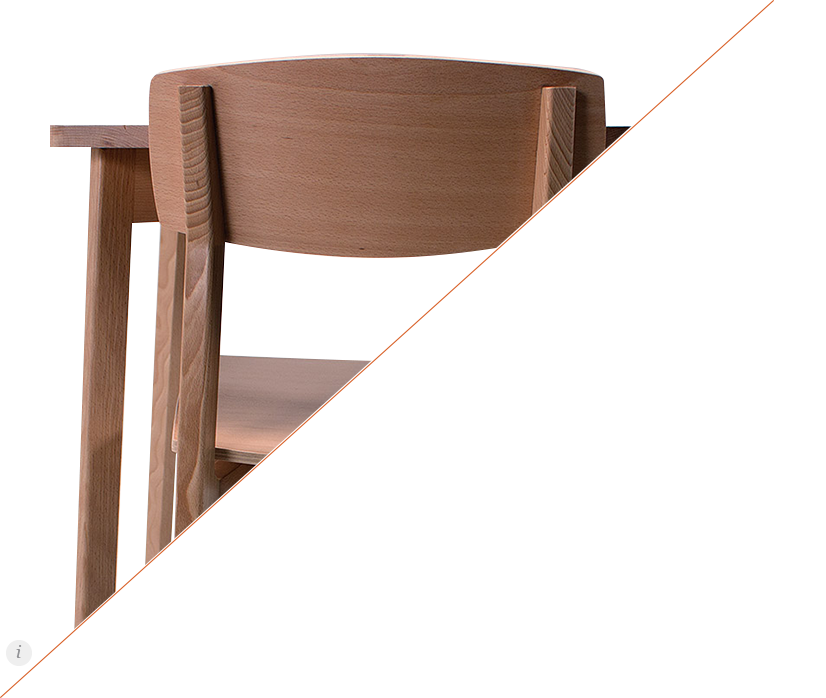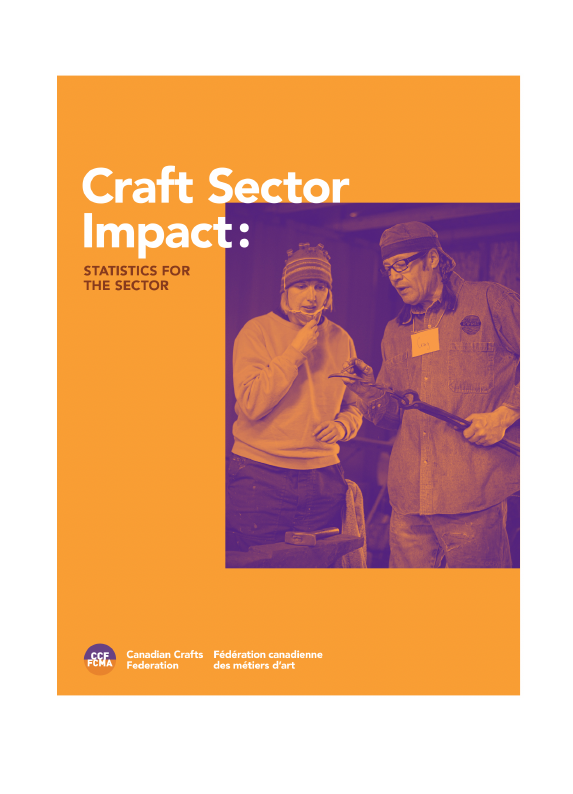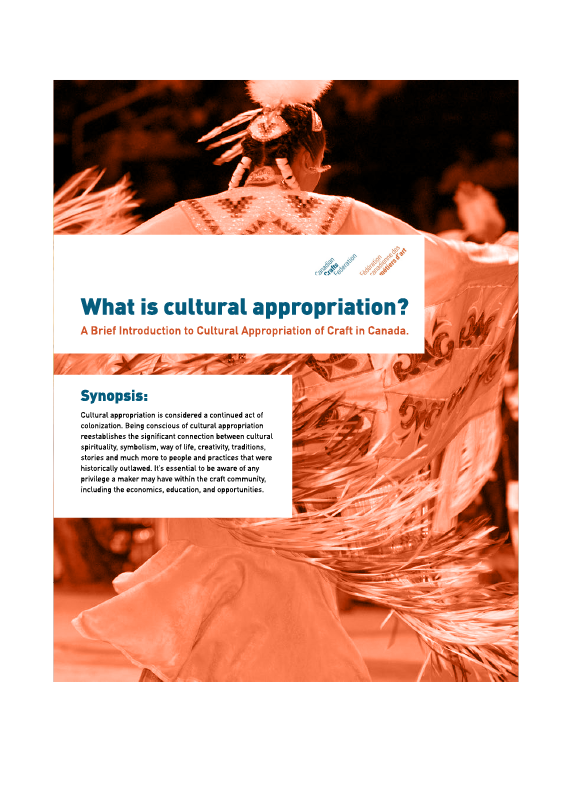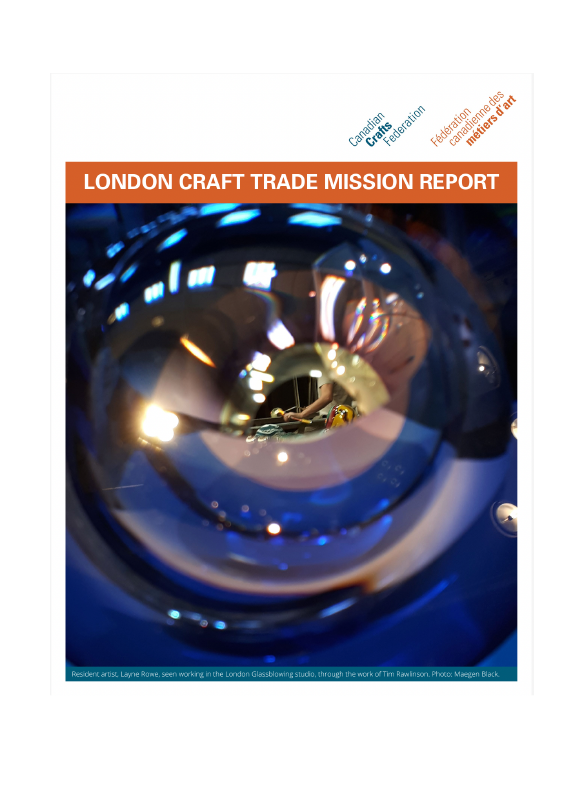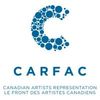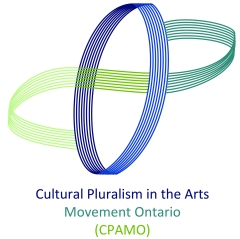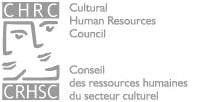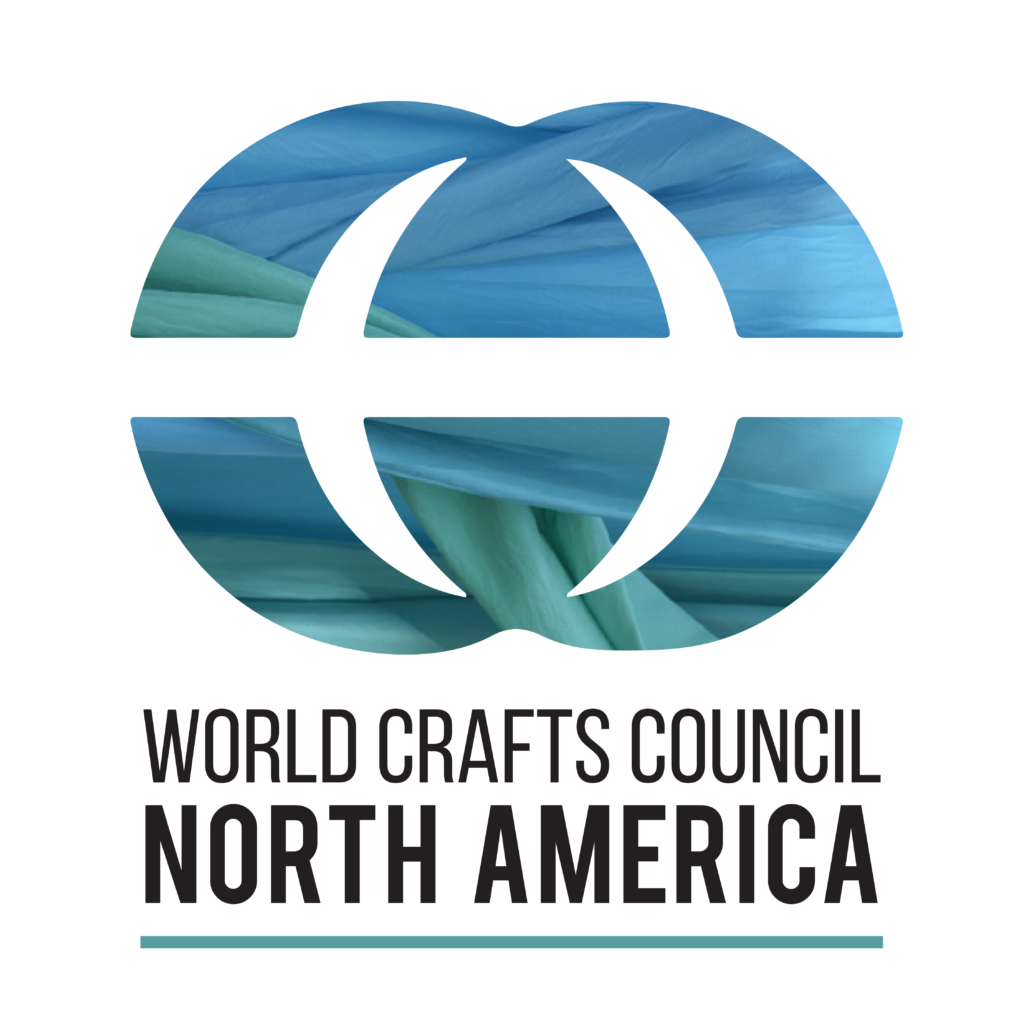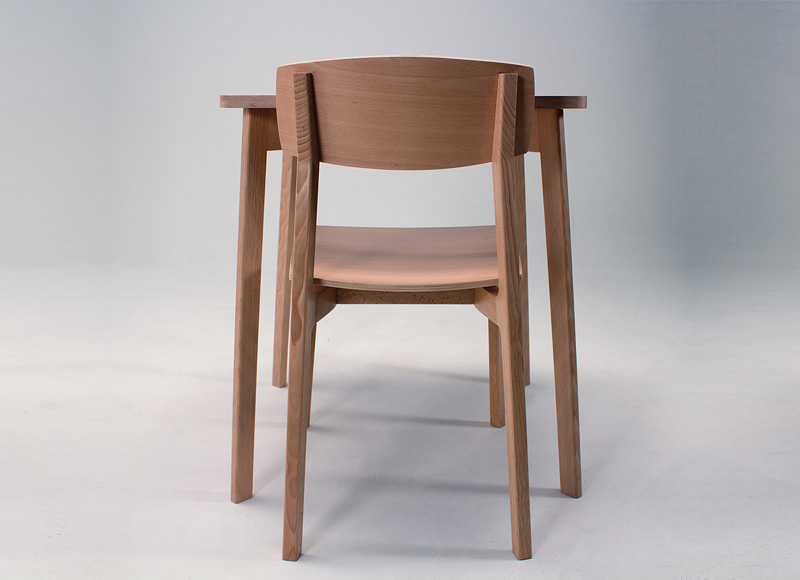Resources
If knowledge is power, and strength is found in numbers, then informing the sector with data, knowledge and contacts is an important part of advancing the craft sector. The following resources are intended to empower you.
Tariffs
Tariffs and the Canadian Craft Sector
As the landscape of trade evolves with the new tariffs recently implemented by the United States and Canada, you and your business have an opportunity for growth and resilience. The CCF/FCMA has crafted this essential guide to empower you with knowledge about tariffs and strategies to navigate challenges. We understand this is an evolving situation and are committed to keeping this information up-to-date.
Tariff Toolkit for Canadian Craftspeople
Last updated: April 1, 2025
Read More ↓
What are tariffs?
A tariff is a tax on goods imported from one country to another. Tariffs can be applied broadly or to specific categories or types of items. Typically, tariffs are a set percentage of the total item value.
As of March 6th, 2025, tariffs imposed by the United States on Canada include :
25% tariffs on goods that do not satisfy U.S.-Mexico-Canada Agreement (CUSMA) rules of origin. The start date for US tariffs has been delayed to April 2nd.
There is currently a lower 10% tariff on those energy products imported from Canada that fall outside the USMCA preference, and a lower 10% tariff on any potash imported from Canada and Mexico that falls outside the USMCA preference (Note that this is usually used for fertilizer; it is also used in some ceramic materials).
No tariffs on those goods from Canada and Mexico that claim and qualify for USMCA preference.
There is a significant exemption for craftspeople that should be noted. Under the Exclusion section of the bulletin, the following products are excluded from the proposed tariffs:
9903.01.12: Articles from Canada that are informational materials, including but not limited to publications, films, posters, phonograph records, photographs, microfilms, microfiche, tapes, compact disks, CD ROMs, artworks, and news wire feeds.
As of March 4th, 2025, the Canadian Government has implemented a first wave 25% retaliatory tariffs for certain goods imported from the United States to Canada. The list includes products such as appliances, apparel, footwear, cosmetics, and certain pulp and paper products.
The government is also taking steps to mitigate the impact of these countermeasures on Canadian businesses by establishing a remission process to consider requests for exceptional relief from the tariffs imposed, especially if the goods being imported are unavailable in Canada. Note that this process can only be applied to the goods currently impacted by tariffs (not the potential 2nd wave of tariffs).
Should the US move forward with more tariffs, the Canadian government intends to impose a second wave of additional countermeasures on April 2nd. This will impact imports from the U.S. and draw from a list of goods open for a 21-day comment period. The list includes products such as electric vehicles, electronics, steel, aluminum, trucks, and buses.
Here’s a short video released by the Canadian Government: What are Tariffs?
If you are uncertain if your product will be subject to tariffs, here is an online tool put together by Canada’s Trade Commissioner Service: https://www.tariffinder.ca/en/
How are tariffs collected?
For items that exceed the de minimis threshold, the collection of tariffs varies based on the market and the shipping carrier, and they are added to the previous duty costs. Generally, buyers are responsible for paying tariffs and any associated handling fees to the final shipping carrier when their items are delivered. In some cases, the pricing provided by postal carriers includes the cost of tariffs, allowing exporters or sellers to display a tariff-inclusive price at checkout. This means that buyers may be required to pay additional tariffs and fees on packages shipped internationally after purchasing an item.
What is a De Minimis Value exemption?
The De Minimis value (meaning too small to be considered) varies from country to country. A De Minimis Value exemption means that if you export goods valued below the specified threshold, those items will be exempt from duties (i.e., tariffs). Note that these have been implemented by the US as a temporary measure and may not be permanent.
In the United States, items imported are subject to duties when their value exceeds USD 800. In Canada, the threshold is USD 20, meaning that if you import goods valued over that amount, you will incur duties (tariffs).
This exemption limit differs significantly across countries. Understanding the applicable De Minimis Value for each country can help you estimate the landed cost—the total cost the customer will pay. This information allows you to communicate the final price to the buyer. De Minimis value by country
How to Reduce Disruptions and Extra Costs for Your Business and Clients:
Be transparent! Before you ship to US buyers, let them know if their order may be subject to tariffs. Confirm with your client that their item(s) are being shipped from Canada, that a tariff may be applied after shipping, and that the client will pay that duty COD.
Conduct internal reviews to evaluate and streamline operations, identify cost reduction opportunities and implement necessary changes.
Start purchasing local or national products; source domestic alternatives to decrease reliance on expensive imports.
Engage in discussions and collaborate with importers and suppliers, and try to share the burden of costs.
Consider marginal cost pricing by setting export prices primarily based on variable costs to maintain competitiveness.
Some indirect implications of the tariffs:
Border Complications: If you ship raw materials or goods from Canada to the US or from the US to Canada, the new rules might mean extra inspections and more paperwork when your goods cross the border. Due to tighter border controls, you might experience longer wait times or added costs.
Connecting with a customs broker could be a good solution for navigating some of these new complexities and ensuring paperwork is accurate. While this will cost you money, it could save you some guesswork! A list of brokers licensed by the Canada Border Services Agency (CBSA) can be found here: https://cscb.ca/en/customs-broker-search.
While the new 25% tariffs on goods crossing between the U.S. and Canada may seem challenging, understanding key aspects—like de minimis exemptions, cost responsibilities, and potential shipment delays—empowers you to plan ahead and adapt. Remember, as trade policies evolve, staying informed and proactive can help you turn these challenges into opportunities for growth and resilience.
Use your voice! Tell the government how the tariffs impact you by filling out this form: Feedback on Tariff Measures
Key Resources & Links
Governmental Statements on Tariffs:
- US Fact Sheet on Imports – February 2nd, 2025
- US Amendment to Tariffs – March 3, 2025
- Canadian List of Products – March 4, 2025
- Canadian Customs Notice – March 4, 2025
- Canadian Tariff Rules and Regulations
Canadian Government and Trade Agencies:
- Tax Relief program for businesses impacted by tariffs – On March 21, 2025, the Government of Canada announced actions to support workers and businesses affected by tariffs.
- Subscribe to the Creative Export Strategy newsletter – The Creative Export Canada (CEC) program, which is part of the Creative Export Strategy, provides visibility and funding to help Canadian creative works achieve financial success abroad.
- Government of Canada – Interprovincial Trade -Government of Canada is removing more than half of the federal exceptions to the Canadian Free Trade Agreement to strengthen Interprovincial Trade
- International Trade – Global Affairs Canada – Explore Canada’s free trade agreements, foreign investment promotion and protection agreements, plurilateral agreements and World Trade Organization agreements.
- Invest Canada – Market Access – Invest in Canada is Canada’s foreign direct investment attraction and promotion agency. This means working with partners across the country and worldwide to attract global companies and support their expansion plans in Canada.
- Export Services – Global Affairs Canada – Learn how to sell your products and services abroad, receive support services, financing, apply for permits and more.
- CanExport SME Applicant Guide – The CanExport SMEs program of Canada’s Trade Commissioner Service is designed to encourage small and medium-sized enterprises (SMEs) to export Canadian goods and services to new international markets.
- Business Benefits Finder – Directory to find grants and contributions, loans, tax credits, wage subsidies and other business support
- Export Checklist – Get information on the obligations, guidelines and procedures for reporting the goods to the Canada Border Services Agency (CBSA).
- Trade Commissioner – The Trade Commissioner Service helps Canadian businesses grow by connecting them with funding and support programs, international opportunities, and a network of trade commissioners worldwide.
The Impact of Tariffs on Canada’s Craft Sector
Last updated: April 1, 2025
Read More ↓
Context and Economic Significance
Canada’s craft sector is a vital part of the creative industries, making a significant contribution to the nation’s economy and cultural heritage. In 2022 alone, Canada’s creative industries, including crafts, generated approximately $58.5 billion in GDP, accounting for 2.1% of the country’s total GDP and employing 648,825 people. Specifically, the craft subsector, which includes textiles, jewelry, ceramics, furniture, housewares, musical instruments, and other handmade craft objects, made substantial contributions with exports valued at $5.9 billion to the United States.
Dependence on the U.S. Market
The United States has consistently been Canada’s largest export market for creative goods. In 2022, U.S. exports accounted for 68% of Canada’s total creative exports. Within this framework, the craft sector stands out prominently:
- Craft alone accounted for $5.9 billion, making it the largest category within Canada’s creative exports to the U.S.
- The craft sector’s exports to the U.S. represented 88.8% of the total exports from this subsector, illustrating an exceptionally high dependence.
Current Tariff Crisis
The re-election of President Donald Trump in 2024 and subsequent invocation of the International Emergency Economic Powers Act (IEEPA) led to a dramatic shift in the trade relationship between Canada and the U.S. Effective March 4, 2025, a 25% tariff was imposed on Canadian imports, although temporarily deferred for goods qualifying under the Canada-United States-Mexico Agreement (CUSMA) until April 2, 2025
Immediate Financial Impact
The craft sector is anticipated to face severe repercussions from these tariffs:
- The Crafts sector, which exported $5.9 billion worth of goods to the U.S. in 2022, is expected to experience the most significant financial impact. Canadian Heritage (PCH) estimates that with a 25 percent U.S. tariff, exports would decrease by $736 million to $1.5 billion, representing 11 percent to 22 percent of all Canadian Crafts exports (goods and services) to the world.
- Further compounding this issue, the threatened removal of the de minimis exemption, previously allowing duty-free shipping for goods under $800, would significantly raise operational costs, reduce competitiveness, and impact profit margins for Canadian craft businesses exporting to the U.S.
Broader Economic Consequences
Beyond immediate revenue losses, these tariffs could trigger a broader economic downturn affecting multiple sectors:
- Production costs for craft businesses would escalate due to increased costs of key imported materials like metals, textiles, and jewelry components, targeted by Canada’s retaliatory tariffs.
- Consumer confidence could diminish, leading households to prioritize essential goods over non-essential items, further reducing demand for craft.
- According to Oxford Economics Canada, the Arts, Entertainment, and Recreation sectors could experience a 5% to 6% decline in their economic value due to broader economic instability caused by tariff increases. These increases affect secondary income sources, such as community courses that are common offerings among professional craftspeople.
Canada’s Response and Need for Further Action
The Government of Canada has responded to the U.S. imposing tariffs on Canadian goods by introducing two retaliatory tariffs. Round one, which entered into force on March 4, 2025, targets goods worth approximately CA$30 billion and includes a limited list of cultural products, mainly from the Crafts sector (particularly apparel (shirts, pants, coats), accessories like handbags (leather) and some types of jewelry), and Visual Arts sector (e.g., paintings and drawings).
The second round, which targets a broader list of goods worth approximately CA$125 billion, was initially scheduled to take effect on March 25, 2025, but was delayed until April 2 in response to the U.S. waiving the 25 percent tariffs on CUSMA-compliant Canadian goods. The round two list targets a broader list of goods worth approximately CA$ 125 billion.
Canada’s retaliatory tariffs will raise the cost of key primary materials imported from the U.S. by Canadian Craft and Visual Arts businesses. Round one targets materials such as metals, textiles, and jewelry, while round two, if implemented, would affect goods like paper, pencils, paints, and varnishes. These tariffs could drive up production costs, reduce profit margins, and reduce the competitiveness of affected businesses.
To mitigate these impacts, the Government of Canada has introduced counter-tariffs on U.S. imports, established a $5 billion Export Development Canada fund, and launched a $500 million favorable loan program via the Business Development Bank of Canada, specifically aimed at supporting businesses directly impacted.
However, given the scale of the potential impacts, these measures alone are insufficient, and many craftspeople would need assistance navigating these applications. Additional supports required include:
- Extended and increased direct financial support targeted explicitly at craft entrepreneurs and businesses to navigate the operational and economic disruptions caused by tariffs.
- Enhanced export diversification initiatives and trade missions to reduce dependency on the U.S. market by expanding market opportunities in Europe, Asia, and Latin America.
- Clear guidance and advocacy efforts to navigate exemptions and reduce border processing disruptions, particularly under the ambiguous IEEPA “informational materials” exemption.
If you and your business are impacted by the tariffs, see our Tariff Toolkit to find resources:
[insert link]
[1] Statistics Canada, International trade of culture and sport products (2022). Due to measurement limitations, however, estimates of trade for the Craft sub-domain may be overstated, as the sub-domain currently includes various manufactured products, that originate from creative artistic activities as well as hand-made craft goods.
[2] Statistics Canada, International trade of culture and sport products (2022).
[3] Statistics Canada, International trade of culture and sport products (2022).
[4] All Canadian cultural goods are eligible to enter the U.S. duty-free under CUSMA if they are sufficiently produced or transformed within North America. Eligibility criteria are primarily outlined in Chapter 4 titled “Rules of Origin and Origin Procedures”.
[5] https://www.oxfordeconomics.com/
[6]
[7] Under IEEPA there is an exception for “information and informational materials” under which the Books and Periodicals sector appear to fall. This category includes items such as publications, films, posters, phonograph records, photographs, microfilms, microfiche, tapes, compact disks, CD ROMs, artworks and news wire feeds. The scope of this exception remains unclear. U.S. Customs and Border Protection has yet to publish a list of Harmonized System codes in the Federal Register to clarify which goods qualify under the exception.
Craft Glossary
Canadian Craft Glossary
Decode Craft jargon with this regularly updated Canadian Craft glossary. The Canadian Craft Glossary lists common craft words, acronyms and phrases. Did you see an error or have a suggestion to add? Please, send us a message.
Craft Glossary: A
Academic
Relating to education and scholarship
Accelerator
An additive to speed up the chemical reaction between the catalyst and resin
Aesthetic
A particular approach to something is pleasing to the eyes
Affiliates
An affiliate is a subordinate group or organization associated with a larger group or organization
Antique Glass
Also known as “mouth-blown glass,” this type of glass is made at the end of a blowpipe in accordance with historic glass manufacturing processes
Appliqué
Cut-out elements that are added to a sewing project to give added dimension or interest
Appropriation
A strategy used by artist who intentionally borrow, copy, and alter existing images and objects
Archival
A permanent and durable material
Artisan
A worker in a skilled trade, especially one that involves making things by hand such as carpentry, leather crafting, jewelry making, and many more
Artist
A person who creates art that can be a painting, sculpture, music, or writing
Artist’s Book
A medium of artistic expression that uses the form or function of the book as inspiration
Artist-Run Centres (ARCs)
Non-profit organizations governed by a majority of artists, dedicated to providing alternative venues to the established art gallery system, supporting the production of new and innovative artistic forms and methods, and facilitating peer-to-peer networking
Craft Glossary: B
Baguette
A thin, long gemstone normally cut with just 14 to 18 parallel facets
Basketry
The art of making baskets with interwoven materials like wicker, wood, grass, bamboo etc.
Batik
A textile design technique using wax as a resist against coloured dyes
Batting
The material used between the quilt top and backing
Beadwork
The use of beads in decoration; beads may be individually stitched, applied in threaded lengths, or woven into the weft of the material. Beading has a very long artistic and cultural history among the Indigenous people in Canada
Bias
Any diagonal line between the crosswise or lengthwise grain line in woven fabric
Biscuit
A small wafer of wood that is inserted and glued to an edge groove between two pieces of wood to be joined
Bleeding
Refers to ink or marker seeping through the backside and sometimes to the next sheet of paper
Blowpipe
Refers to an iron or steel tube, usually four to five feet long, used to blow a bubble of air into a gather of molten glass
Braising
A metal-joining process in which two or more metal items are joined together by melting and flowing a filler metal into the joint to form a strong load-bearing joint
Craft Glossary: C
Canework
In glassblowing, cane are coloured lengths of glass made by stretching molten glass into a long rod. Once cane has been produced, it can be used to make patterns in glass vessels, beads, small sculptural objects, and other artistic creations
CARFAC
Canadian Artists’ Representation/Front des Artistes Canadiens
Casting
Making a mould of a form then using it by pouring liquid material into the mould
CCBC
Craft Council of British Columbia
CCF/FCMA
Acronym for the Canadian Craft Federation/Federation Canadienne des Metiers d’Art
Ceramic
Made of clay and hardened by heat
CERF+
Craft Emergency Relief Fund and Artist Emergency Resources
Chiaroscuro
A manipulation of light and shadow to add life and three-dimension to their images
Chin-colle
A process that introduces colour and texture into an etching without having to prepare and print additional plates
Citizens of Craft
A movement of makers, of appreciators, of shoppers, of admirers – of anyone whose values match our values of heritage, innovation, the leading edge, traditional, authentic, and entrepreneurial
Cleavage
The ability of a rock mass to break along glat planar surface or certain lines of weakness in the structure of the rock’s crystal lattice
CMAQ
Acronym for the Conseil des Metiers d’Art du Quebec
CoC
Acronym for Citizens of Craft
Coldwork
Any process that alters the state of the glass without using heat. Commonly used cold work techniques include sandblasting, engraving, cutting, polishing, painting, and bonding
Collaborate
To work together with someone else for a particular purpose
Colour Family
A collection of the tones and shades that make up a colour
Compatible
Material that can be fused together without excessive residual stress
Couching
An embroidery technique in which strips of fabric, string etc are stitched onto the piece of work. The end result produces a ‘zipped’ effect
CPAMO
Acronym for Cultural Pluralism in the Arts Movement Ontario
Craft
An activity involving skill and creating things by hand
Craft Industry
Goods that re handmade by artisans or those skilled in a particular trade
Craft Production
Manufacturing by hand
Craft Retail
Retail businesses such as galleries, craft store, online shop or boutique
Crafters
A person who has a hobby or small business of hand crafted items
Craftsmanship
A skill that has been acquired in a particular craft
Craftspeople
A person skilled in a particular craft
Creations
A thing that has been made
Crochet
A soft craft that uses a small hook to interlock loops of yarn together to create blankets, toys, jewellery and more
Cross Stitch
A type of counted embroidery that uses small crosses or ‘x’s to create a tiled pattern or design
Culture Appropriation
When a dominant culture uses the culture elements of a minority group outside of their original culture content
Curator
A person whose manages a collection and organize exhibitions
Cure Time
The length of time it takes for the material (resin or silicone) to completely set or harden
Craft Glossary: D, E, F
Dalle de Verre
From French: “glass slab,” this is a glass art technique of sawing or breaking thick coloured slabs of glass and setting them in liquid cement, epoxy, or other supporting materials
Debossing
The process of lowering an area of paper
Die-cutting
A technique where metal dies are used in a manual or electronic machine to cut words, shapes and designs into a range of materials, including card, fabric, foil and more
Distress
A technique that is used to make a project look antiquated, or vintage
Drag
Refers to the weight of a quilt pulling while sewing
Earthenware
Sometimes known as terracotta, a fine-grained clay body fired at low temperatures, resulting in pottery that is slightly porous and coarser than stoneware and porcelain. It can be made impervious to liquids with glaze
Embellishment
An additional decorative element added to a project to finish it off
Embossing
The process of raising an area of paper
Embroidery
The craft of decorating fabric with thread using a needle
Enamelling
A technique in which powdered glass is fused to a metal, glass, or ceramic base in the heat of a kiln to create glossy, vividly coloured metal objects
Exhibitions
A public display of works of art
Felting
The process of separating and relocking the fibres in yarn or wool, most commonly through needle felting—matting wool with a barbed or notched needle—and wet felting—combining fibres with agitation, soap, and water
Fibre
A natural or synthetic structure that is significantly longer than it is wide
Findings
Small jewellery making components
Float Glass
A type of sheet glass produced by floating molten glass in a bath of liquid metal of a low melting point, typically tin
Craft Glossary: G, H, I
Gaffer
The head glassblower in charge of a chair, or team, of hot-glass workers
Gallery
A room or building for the display or sale ow works of art
Glass
A substance made by fusing sand with soda, lime and sometimes other ingredients
Glass Fusing
The process of joining compatible sheet glasses together in a kiln to fabricate plates, tiles, bowls, jewelry, wall hangings, and other artistic creations
Glaze
A vitreous substance fused on to the surface of pottery to form a hard, impervious coating
Goldsmith
A person who makes objects from gold
Hand Building
A ceramics technique that allows artists to create forms with clay using their hands and other tools, but without the use of a throwing wheel
Handcraft
Something made with skill by hand
Handicrafts
Decorative objects made by skilled hands
Hard Crafts
Non-textile based crafts, for example papercrafts (including cardmaking, scrapbooking, book-making, etc), mixed media, polymer clay, beading, woodwork, etc.
Hardy
A blacksmithing chisel that has a square shank, which prevents it from rotating when placed in the anvil’s hardy hole. It is used with a hand hammer for cutting both hot and cold metal
Hide
An animal skin treated for human use through stretching, drying, and tanning. Indigenous people across Turtle Island have developed processes of making animal hides into wearable leather for clothing, shelter, and ceremony over generations
Hot Shop
A glassblower’s studio with the equipment necessary to physically work with glass in its molten state
HTV
Heat Transfer Vinyl
ICCA
Indigenous Curatorial Collective / Collectif des commissaires autochtones
Installation
Large-scale, three-dimensional constructions, often designed to transform specific spaces
Interfacing
A layer of material used to stabilize the fabric. Interfacing can be woven or non-woven, fusible or sew in and is available in various weights and thicknesses depending on its intended use
Craft Glossary: J, K, L, M
Jacquard Loom
A loom originally controlled by a chain of punched cards laced together into continuous sequences to create intricate designs in fabric. In today’s Jacquard weaving, punch cards have evolved into electronic files
Juried vs. Non-Juried
A juried exhibition, sale, or show requires potential artists to submit images or samples and information about the work they hope to display or sell to a selecting jury. A non-juried show allows artists to apply without having to present their work in advance, often on a first-come, first-serve basis
Knitting
A craft where loops of yarn (“stitches”) are created in a line, using two long needles, or a knitting machine
Lampwork
Also called “flameworking,” this type of glasswork uses a torch to melt and shape glass
Lapidary
A person, or the craft, of cutting, grinding, shaping, or polishing stones, semi-precious stones, or gemstones
Loom
A frame or machine for making cloth by weaving two or more sets of threads or yarns
Lost Wax Casting
Also known as “investment casting,” this is the process by which an object is cast from a wax model. Lost wax casting involves building a mold around a sacrificial wax model. After the mold investment is set, the wax is melted out and forms a cavity where the metal or glass flows in
Manifesto
A written statement declaring publicly the intentions, motives, or views of its issuer
Market
To advertise or promote something
Marquise
A cut oval gemstone which tapers to a point at both ends
Matrix
The physical surface which the artist manipulates to hold ink, which is then transferred to paper or other materials like blocks of wood or plexiglass
Members
Belonging to a group or organization
Metal Work
The activity of making items with metal
Mill Scale
The bluish-black flaky surface formed on the outer surfaces of plates or sheets of hot rolled steel
Miniature
A small-scale reproduction of something typically much larger
Mixed Media
A form of artwork or crafting where multiple mediums are used, for example, paper and fabric
MMAQ
Maison des Metiers d’Arts de Quebec
Mordant
For dyeing fabrics by forming a coordination complex with the dye, which then attaches to the fabric
Mosaic
A pattern or image made of small regular or irregular pieces of coloured stone, glass or ceramic, held in place by plaster/mortar and covering a surface
MUMAQ
Musee des Metiers d’Art du Quebec
Murrine
An Italian term for coloured patterns or images made in glass cane that are revealed when cut in cross-sections
Negative Space
The empty or open space between, within and surrounding an object that defines it
Nivingajuliat
A form of appliqué Inuit wall-hanging that developed in Qamani’tuaq (Baker Lake), Nunavut in the 1960s
Craft Glossary: O, P, Q, R
Octopus Bag
Named for their distinctive shape, also called “Fire bags” and “Many legs bags.” Popularized by Anishinaabe people in the Western Great Lakes region, these highly decorated, beaded, and tufted case-skin bags are also made by the Nahkawininiwak, Métis, and Plains Indigenous peoples and are found across many Indigenous nations
Papier-mâché
This paper and glue technique used for shaping everything from animals to planets
Parfleche
Lightweight carrying bags and containers made of rawhide by various Plains Indigenous peoples. Colourful and beautifully decorated with a distinctive style of painted designs, parfleche is considered as much a piece of art as a practical tool
Pâte de Verre
From the French, “paste of glass,” a technique of pressing ground glass powders or frits into a mold and fusing them in the kiln into a desired shape
Platform A
Means to communicate ideas or information to a group of people
Podcast
A digital audio file available on the internet for downloading to a computer or mobile device
Porcelain
A high-firing, fine-grained white clay body that fires to a durable, strong, vitreous ceramic. It is usually pure white because of its high kaolin content
Pottery
The making of clay objects by hand
Pounce
A chalk bag that can be patted over a stencil to quickly and accurately transfer a pattern to fabric
Public Art
Any works of art installed in a public area, whether outdoors or indoors. Usually, but not always, it is commissioned specifically for the site in which it is situated and can include murals, sculpture, monuments, community art, digital new media, and even performance
Pug mill
The potter’s solution for transforming clay scraps into workable clay
Punch
A hard metal object with a sharp tip and a blunt butt end, which is usually stuck by a hammer
Pyrography
Writing with fire or heated tools onto leather or wood
Quillwork
A type of decoration using softened and dyed porcupine quills. Quillwork has been practiced for centuries in many parts of Turtle Island, most notably by the Dene people
Quilting
A form of patchwork where multiple pieces of fabric are sewn together, with quilt padding in between, to create a quilt
Quilting Squares
Small squares of fabric to join together in the making of a quilt
Rag Hooking
The art of making a rug by pulling loops of yarn or fabric through a stiff woven base such as burlap, linen, or rug warp
Raku
A ceramics technique that has evolved from ancient Japanese pottery. Raku pottery is removed from the kiln while it is still in fusion and then is cooled extremely fast, sometimes by plunging a ware into water, sometimes by cooling it naturally in the air, and sometimes by plunging it into some combustible material such as paper, straw or sawdust, reducing oxygen and creating spectacular colours
Rasp
A craftsperson’s tool with a long blade covered with rows of sharp points for scraping, filing, or rubbing down objects of metal, wood or other hard materials that create a smooth surface
Recto
It is the right hand page in a book and is usually numbered with and odd page number.
Riveting
A durable and decorative technique using a cold connection method that secures laters of varied mediums such as metal, leathers and fabrics using a “rivet” along with special tools ans the application of force creating a permanent fastening
RJA
Robert Jekyll Award
Roving
Wool fiber that has been processed but not spun into yarn as of yet
Craft Glossary: S, T, U
Saponification
The process of soap making
SCC
Saskatchewan Craft Council
Sconces
A wall-mounted candle holder or light fixture
Screen Printing
Transferring images by filtering paint or ink through patterned and layered screens onto fabric, canvas or other surfaces
Sculptural
Items made by shaping a material such as wood, clay, metal, or stone
Skein
A length of thread or yearn wrapped/coiled around itself
Slumping
A kilnforming process that uses heat and gravity to transform sheet glass into the shape of a mould
Soapstone
A metamorphic rock composed primarily of talc carved by Northern Indigenous communities into tools and decorative sculptures for over 7,500 years. Today, the term “soapstone carving” is often used to refer to sculptures carved from soapstone as well as other soft, compact carving mediums, including serpentine
Spray Paint
Paint that is contained in an aerosol can for the purpose of spraying onto a surface
Stoneware
A mid- or high-firing coarse-grained clay body that can be anywhere between buff colour to gray to dark brown, because of varying levels of iron and other impurities
Tapestry
A piece of thick cloth with a pattern or picture that is formed by weaving or embroidery, traditionally used as a wall hanging or furniture covering
Textiles
Types of cloth or woven fabric
The Craft Spectrum
Craft exists on a spectrum that encompasses disciplines, materials, tools, and cultures
Tradecraft
The skills learned from experience in a trade
Trades
Buying and selling goods and services OR a skilled job, typically one requiring manual skills and special training
Tufting
A type of textile art in which a thread or hair is inserted on a backing material. Indigenous people—including the Dene, Cree, and Métis—have developed distinct forms of decorative tufting using small bunches of dyed animal hair to create sculpted designs
UFO
Abbreviation of unfinished object
Craft Glossary: V, W, X, Y
VAA/AAV
Visual Arts Alliance/Alliance pour les Arts Visuels
Veneer
This sheets of wood or other material (brass, mother-of-pearl, etc.) used for marquetry
Verso
Which is the left hand page in a book that is usually numbered with an even page number
Warp or Weft
These two terms refer to the directionality of the threads that make up a woven fabric. Warp threads run vertically, whereas warp threads run horizontally
WCC
World Crafts Council
WCCNA
World Craft Council North American Region
Weaving
The craft or action of forming fabric by interlacing threads
Wheel Throwing
The technique of shaping ceramics on a potter’s wheel. The wheel turns constantly, triggered by the potter’s foot, a motor, or the help of collaborators, rotating the clay as the potter shapes it with both hands
Wholesale
The selling of goods in large quantities to be retailed or sold to the public by others
WIP
Acronym for work in progress
Wood Carving
The skill of carving wood to make functional or ornamental objects
Woodcraft
Skill in working with wood
Woodworking
The skill of making things from wood
Wool
A fibre that originates from animals, mostly commonly the fleece of sheep. Wool is the raw material that can be spun into a type of yarn which can be used in knitting, crocheting, weaving, etc.
Workshop
A seminar or a discussion group that emphasizes the exchange of ideas and the demonstration of techniques and skills
Xylopolist
The old formal name for a timber merchant
Yarn
A length of natural or synthetic fibre used to create fabric
Research
Interested in learning more about craft theory? Explore the collection of craft-related research below. These studies, papers, and reports highlight the cultural impact of craft across Canada and beyond. Whether you are a scholar, practitioner, or craft enthusiast, this research provides valuable insights and fosters a deeper understanding of the craft sector.
Craft Sector Impact: Statistics for the Sector
A thorough survey and follow up reporting was conducted by the CCF/FCMA in late 2019 and early 2020, gathering statistics from 10 Provincial and 2 Territorial Craft Councils. The final calculations were reviewed, vetted, and confirmed by the Executive Directors of each organization surveyed.
DOWNLOAD:
Considering Cultural Appropriation
As the national arts service organization for craft in Canada, the CCF/FCMA encourages artists and the public alike to embrace and value the artistic, economic, historic, contemporary, and social significance of craft. This is no easy feat, particularly in a country as broad and diverse as Canada. The history of this land influences and informs our contemporary experiences, and with this in mind, we recognize that craft practices are intrinsically tied to the past, present, and future.This document takes one small step toward encouraging thoughtful and informed consideration and action regarding the harm of cultural appropriation in craft.
DOWNLOAD:
Pathway to Funding :
Craft & The Canada Council for the Arts
Pathway to Funding: Craft & The Canada Council for the Arts, is live online now, produced by the CCF/FCMA (and voiced and animated by our awesome design intern, Noémie Malenfant). The CCF/FCMA created this animation to demystify the Canada Council’s new model and encourage more applications from the craft sector. As craft artists may not immediately see themselves in the language of the new Canada Council for the Arts funding model, this video aims to encourage that connection.
DOWNLOAD:
London Craft Trade Mission Report
From February 28th to March 4th, 2019, seven leaders from the Canadian craft sector explored the London craft scene, building an arsenal of information and new networks for the future. That information has been compiled in the CCF/FCMA’s London Craft Trade Mission Report, a resource that can be used by Canadian crafts artists and organizations who want to make connections with or learn about the UK craft scene.
DOWNLOAD:
Senator Patricia Bovey’s Speech, Identity: Artists, The Senate & Canada
At the CCF/FCMA’s 2018 national crafts conference in Nova Scotia, “Placemaking: The Unique Connection Between Craft, Community + Tourism, Lunenburg Keynote Speaker, the Honourable Senator Patricia Bovey, gave her speech, Identity: Artists, The Senate & Canada. Click here to read it, and download our graphic below featuring a few highlights from her speech.
DOWNLOAD:
Craft Think Tank Report
From October 19th to the 21st, 2017, the CCF/FCMA participated in the exclusive Craft Think Tank on Craft Education, hosted by the American Museum of Ceramic Art in Pomona, California. For three days, thirty-five delegates (each in attendance by invitation of the organizers) exchanged information and ideas about the state of craft in America. Read through our report on the event, and be immersed in the many resources, references, and ideas shared throughout the event.
DOWNLOAD:
Craft Year 2015 Infographic
Craft Year 2015: the biggest, broadest celebration of contemporary fine craft ever hosted in this country. It’s not just a claim, we have the stats to back it up!
Throughout the year, craft artists, institutions, associations, and the general public took part, attending a record-breaking 884 events, up 25% from our previous number during Craft Year 2007. Find out more about what events took place and where, as well as the online Craft Year experience, in our Craft Year 2015 infographic.
DOWNLOAD:
Infographic: Craft Councils at a Glance 2015
The CCF/FCMA is proud to bring you this visual research compiled over the course of 2015. As an organization of organizations, we know the value of networking and collaboration, and that the impact our members make helps to define the craft community. ‘Craft Councils at a Glance’ showcases the scope of the councils and their work.
DOWNLOAD:
Canadian Culture Satellite Account 2010 (released in 2014)
This paper articulates the Canadian Culture Satellite Account (CSA) developed by Statistics Canada. The Canadian CSA provides measures of the economic importance of culture (inclusive of the arts and heritage) and sport in Canada in terms of output, gross domestic product and employment, for reference year 2010. The biggest take-away from the report is: that culture represents $47.8 billion worth of GDP, and of that total, $2.8 billion is attributed to the Craft sector.
DOWNLOAD:
Profile and Development Strategy for Craft in Canada: 2003
A Study Coordinated by Conseil des métiers d’art du Québec (CMAQ) for The Canadian Craft Federation/Fédération canadienne des métiers d’art (CCF/FCMA) and prepared by Bert Pereboom, Peartree Solutions Inc., October 2003.
This study provides a qualitative and quantitative profile of the craft sector in Canada. It is the first study to utilize a consistent methodology to measure craft activity across Canada. The study was also the first attempt to develop a cohesive domestic and international development strategy for the craft community in Canada. It reveals that the sector is largely populated with skilled craftpersons working in home-based and other small studios producing one of a kind work or production work. Craft activities are estimated to support some 22,600 individuals, generating total output valued at $727 million, and exports approaching $100 million dollars annually, representing 16 percent of craft revenue of the survey respondents.
DOWNLOAD:
- ENGLISH STUDY PDF
- ENGLISH APPENDICES
- Portrait et stratégie de développement des métiers d’art au Canada
- les appendices du rapport
Traditional Craft Trades as Employers and Training Mechanisms for Canadian Youth: 2013
The Vancouver Island University has released a study on what they are calling ‘Traditional Craft Trades’ and the role they play in protecting Canada’s heritage. An interesting take on craft, which includes artistic practices as well as the more agriculturally tied craft activities, the study concludes with more questions we should all consider. (Unfortunately, this study is only available in English).
DOWNLOAD:
Canadian Fine Craft Niche Market Study: 2005
Initiated by the Trade and Investment Development Directorate of the Department of Canadian Heritage, in cooperation with the Trade Team Canada Cultural Goods and Services Working Group (TTC-CGS) for Crafts, this study focuses on the niche connections in crafts. It identifies the trends, habits, experiences, and conditions of Canadian fine craft exporters, as well as the niche market opportunities with particular potential for Canadian fine crafts people.
DOWNLOAD:
Report – Market Intelligence for the Buyers Market of American Craft: 2003
Prepared by Heather O’Hagan, former Executive Director Crafts Association of BC, for the Department of Foreign Affairs and International Trade. Funding provided by the Department of Canadian Heritage, The Canadian Consulate in New York and International Trade Canada.
This report offers detailed information and observations about the Buyers Market from a Canadian participant’s perspective.
DOWNLOAD:
Craft International Trade Action Plan
Developed by Tom McFall, Executive Director of the Alberta Craft Council and Chair of the Trade Team Canada – Cultural Goods and Services Working Group for the Craft sector; Anne Manuel, Executive Director of the Craft Council of Newfoundland and Labrador; Louise Chapados, Director of Development for Services and Exports of the Conseil des métiers d’art du Québec; Rosalyn Morrison, former Executive Director of the Ontario Crafts Council; and Susan Greene, former Senior Trade Officer responsible for Craft with the Trade Routes program of the Department of Canadian Heritage.
Based in large part upon the research and findings presented in the document “Profile and Development Strategy for Craft in Canada,” (see above), the scope of the action plan is limited to recommendations for action on the part of the Government of Canada.
DOWNLOAD:
Marketing Guide for Contemporary Fine Craft in the United States: 2002
Commissioned by the Department of Foreign Affairs and International Trade in 2002. Managed by the Crafts Association of British Columbia, co-authored by Dana Boyle, Business Development Officer with the Canadian Consulate General In Minneapolis, Minnesota, and Lou Lynn, artist and faculty member at the Kootenay School of the Arts in Nelson, British Columbia.
The guide is a source of information for craftspersons interested in entering US markets or expanding their US exposure. Topics include: Getting Ready to Go, Working with Galleries, Preparing to Export and Border Issues. Also included are: tips for preparing portfolios; advice about approaching US galleries; descriptions of wholesale and retail shows; and more.
Find recommendations for converting your prices for selling in the US market, classifying your work for US customs, finding customs brokers, shipping, working with embassies and consulates, and much more.
DOWNLOAD:
Study of the Crafts Sector in Canada: Inventory and Summary of Current Literature; Defining the Crafts Sector; Working Together to Develop the Crafts Sector: 2001
Coordinated by Conseil des métiers d’art du Québec (CMAQ) for the CCF/FCMA. Prepared for Industry Canada and the Department of Foreign Affairs and International Trade (DFAIT) by Bert Pereboom, Peartree Solutions Inc.
DOWNLOAD:
Education
Unlock a world of learning with our comprehensive educational resources dedicated to Canadian craft. Explore a variety of opportunities for higher education in the arts, including specialized programs, workshops, and online courses that can help you advance your fine craft career.
Craft Education Across Canada
BRITISH COLUMBIA
- Kwantlen University College | Bachelor of Design | Fashion & Technology
- University College of the Fraser Valley | Fashion Design Diploma
- Emily Carr Institute of Art + Design | Bachelor of Fine Arts | Ceramics
- Selkirk College | Kootenay School of the Arts
- Langara College | Fine Arts Diploma | Ceramics
- Vancouver Community College | Jewellery, Gemmology, Fashion Design and Production.
For a complete listing of educational institutions, including summer school and private and part-time opportunities in British Columbia, visit the Craft Council of British Columbia’s website.
ALBERTA
- Alberta University of the Arts | Bachelor & Masters of Fine Arts | Ceramics, Jewellery + Metals, Glass, and Fibre
- Red Deer College | Series Summer School | Ceramics, Wood, Glass, Metal, Fibre
- Northern Alberta Institute of Technology | Woodworking, Blacksmithing
- Portage College | Unlock Your Creative Potential
SASKATCHEWAN
- University of Saskatchewan | Jewellery, Fibre Art, Glass, Printmaking
- University of Regina | Bachelor of Fine Arts and Masters of Fine Arts | Sculpture, Ceramics and Printmaking
- Timeless Instruments School of Luthiery | Luthier programs
MANITOBA
- University of Manitoba | Ceramics
ONTARIO
- Georgian College | Jewellery & Metals, Goldsmithing & Silversmithing
- OCAD University | Bachelor of Design or Bachelor of Fine Arts in Material Art & Design | Master of Design/Master of Fine Arts/Master of Design in Interdisciplinary Master’s in Art, Media and Design (IAMD)
- Sheridan College | Bachelor of Craft & Design |Textiles, Ceramics, Furniture, Glass
- George Brown College, Centre for Arts & Design | Fashion, Jewellery
- Seneca College | Fashion Arts Diploma Program
- Ryerson University | Bachelor of Design and Master of Arts in Fashion
- Fleming College, Haliburton School of the Arts | Blacksmithing, Ceramics, Jewellery, Glassblowing, textiles
QUÉBEC
- Institut des métiers d’art : Cégep du Vieux-Montréal | Céramique, Construction Textile & Impression Textile, Ébénsterie artisanale, Joillerie, Lutherie-guitare, Maroquinerie, et Verre
- Centre de formation et de consultation en métiers d’art :Cégep de Limoilou | Céramique, Construction Textile, Ébénsterie artisanale, Joillerie, et Lutherie
- Concordia University | Bachelor of Art in Ceramics and Fibre
- Espace Verre | Glass
- École de joillaire | Jewellery
- Centre de design et impression textile de Montréal | Textiles
- Centre des textiles contemporains de Montréal | Diploma & Workshops in Textiles
NEW BRUNSWICK
- New Brunswick College of Craft and Design | Diplomas in Aboriginal Visual Arts, Ceramics, Fashion Design, Jewellery/Metal Arts, and Textile Design
NOVA SCOTIA
- Nova Scotia College of Art & Design University | Bachelor of Fine Arts in Ceramics, Jewellery Design & Metalsmithing, Textiles & Fashion
- The Cape Breton Centre for Craft & Design | Workshops | Clay, Jewellery, Textiles
- Nova Scotia Centre for Craft & Design | Workshops | Glass, Clay, Wood, Textiles, Jewellery
NEWFOUNDLAND & LABRADOR
- College of the North Atlantic | Textiles: Craft & Apparel Design
- Craft Council of Newfoundland & Labrador | Clay Studio Courses
NUNAVUT
- Nunavut Arctic College | Fur Design & Production, Jewellery & Metalwork, Goldsmithing
NORTHWEST TERRITORIES
- Aurora College | Traditional Arts Certificate
YUKON
- Arts Underground | Workshops in Textiles, Clay and Glass
Resources
Artifex is a publicly accessible resource database that was created in 2019-20 through a partnership between Mass Culture and the Creative Hubs and Networks Database at University of Toronto Scarborough (UTSC) with support from the Critical Digital Methods Institute (CDMI). The database provides exchange and dissemination of knowledge and research links, making it a key information resource for anyone working in or interested in the arts and cultural sector in Canada. The database is important to policy makers, creative workers and artists, researchers and academics, media, funders and general interest audiences.
CARFAC (Canadian Artists’ Representation/Front des Artistes Canadiens) is a national nonprofit group dedicated to defending Canadian artists’ economic and legal rights. They also direct research and promote Canadian art. Fee schedules, copyright information, and other invaluable information can be found on their website or through a provincial representative.
Copyright Visual Arts is a not-for-profit copyright management society providing Author’s Rights administration for professional Canadian and Québécois visual and media artists.
Cultural Pluralism in the Arts Movement Ontario (CPAMO) is a movement of Indigenous and racialized artists engaged in empowering the arts communities of Ontario. CPAMO seeks to open opportunities for Indigenous and racialized professionals and organizations to build capacity through access and working relationships with cultural institutions across Ontario that will result in constructive relationships with Indigenous and racialized professionals and organizations.
The Cultural Human Resources Council has multiple studies on employment and careers in the Canadian cultural sector. The CHRC also provides extensive information in both official languages about opportunities for cultural employment, including Craft. Here you can learn about what it takes to work in any given cultural field, browse Internship programs and Job opportunities, review research studies, and more. Of particular interest is the Art of Managing Your Career, a resource guide for cultural careers in all fields, with detailed information about the craft sector as a whole in both English and French.
CERF+ (the Craft Emergency Relief Fund and Artist Emergency Resources) is the resource for craftspeople looking for information on emergency preparedness and how to deal with a disaster. Information is available on their website about safeguarding, disaster planning, cleanup, salvage and e-salvage, and is freely accessible online to Canadians.
The Indigenous Curatorial Collective / Collectif des commissaires autochtones (ICCA) engages in critical discourses, increases professional opportunities for our members, develops programming, and most importantly works to build reciprocal relationships with Indigenous curators, artists, communities and the institutions we engage with.
The World Craft Council North American Region (WCCNA) is one of five regions represented in the World Craft Council International (WCC) organization. Volunteers power the effort of the WCCNA, to encourage connections and build networks between North American craft and the rest of the world, ensuring that Northern American, Central American, and Caribbean craft is known and appreciated as a reflection of our collective, unique and diverse North American culture.

